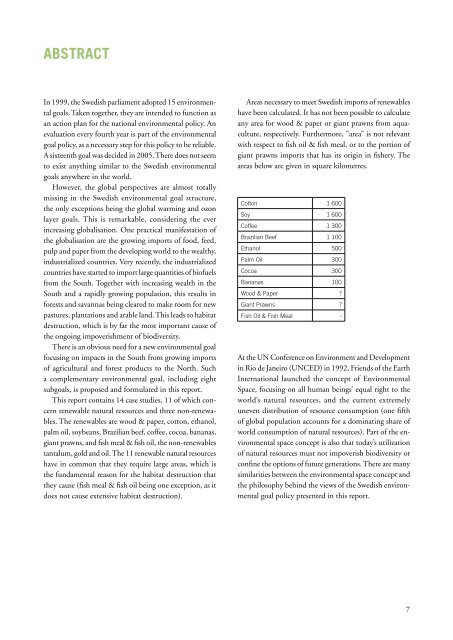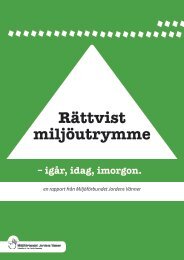Det saknade miljömålet - Jordens Vänner
Det saknade miljömålet - Jordens Vänner
Det saknade miljömålet - Jordens Vänner
You also want an ePaper? Increase the reach of your titles
YUMPU automatically turns print PDFs into web optimized ePapers that Google loves.
abstract<br />
In 1999, the Swedish parliament adopted 15 environmental<br />
goals. Taken together, they are intended to function as<br />
an action plan for the national environmental policy. An<br />
evaluation every fourth year is part of the environmental<br />
goal policy, as a necessary step for this policy to be reliable.<br />
A sixteenth goal was decided in 2005. There does not seem<br />
to exist anything similar to the Swedish environmental<br />
goals anywhere in the world.<br />
However, the global perspectives are almost totally<br />
missing in the Swedish environmental goal structure,<br />
the only exceptions being the global warming and ozon<br />
layer goals. This is remarkable, considering the ever<br />
increasing globalisation. One practical manifestation of<br />
the globalisation are the growing imports of food, feed,<br />
pulp and paper from the developing world to the wealthy,<br />
industrialized countries. Very recently, the industrialized<br />
countries have started to import large quantities of biofuels<br />
from the South. Together with increasing wealth in the<br />
South and a rapidly growing population, this results in<br />
forests and savannas being cleared to make room for new<br />
pastures, plantations and arable land. This leads to habitat<br />
destruction, which is by far the most important cause of<br />
the ongoing impoverishment of biodiversity.<br />
There is an obvious need for a new environmental goal<br />
focusing on impacts in the South from growing imports<br />
of agricultural and forest products to the North. Such<br />
a complementary environmental goal, including eight<br />
subgoals, is proposed and formulated in this report.<br />
This report contains 14 case studies, 11 of which concern<br />
renewable natural resources and three non-renewables.<br />
The renewables are wood & paper, cotton, ethanol,<br />
palm oil, soybeans, Brazilian beef, coffee, cocoa, bananas,<br />
giant prawns, and fish meal & fish oil, the non-renewables<br />
tantalum, gold and oil. The 11 renewable natural resources<br />
have in common that they require large areas, which is<br />
the fundamental reason for the habitat destruction that<br />
they cause (fish meal & fish oil being one exception, as it<br />
does not cause extensive habitat destruction).<br />
Areas necessary to meet Swedish imports of renewables<br />
have been calculated. It has not been possible to calculate<br />
any area for wood & paper or giant prawns from aquaculture,<br />
respectively. Furthermore, ”area” is not relevant<br />
with respect to fish oil & fish meal, or to the portion of<br />
giant prawns imports that has its origin in fishery. The<br />
areas below are given in square kilometres.<br />
Cotton 1 600<br />
Soy 1 600<br />
Coffee 1 300<br />
Brazilian Beef 1 100<br />
Ethanol 500<br />
Palm Oil 300<br />
Cocoa 300<br />
Bananas 100<br />
Wood & Paper ?<br />
Giant Prawns ?<br />
Fish Oil & Fish Meal -<br />
At the UN Conference on Environment and Development<br />
in Rio de Janeiro (UNCED) in 1992, Friends of the Earth<br />
International launched the concept of Environmental<br />
Space, focusing on all human beings’ equal right to the<br />
world’s natural resources, and the current extremely<br />
uneven distribution of resource consumption (one fifth<br />
of global population accounts for a dominating share of<br />
world consumption of natural resources). Part of the environmental<br />
space concept is also that today’s utilization<br />
of natural resources must not impoverish biodiversity or<br />
confine the options of future generations. There are many<br />
similarities between the environmental space concept and<br />
the philosophy behind the views of the Swedish environmental<br />
goal policy presented in this report.<br />
7





